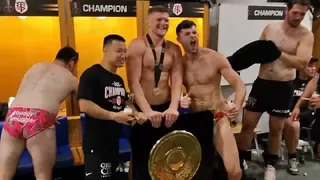April 22, 2005
Gay History in Germany
Jason Salzenstein READ TIME: 5 MIN.
In the United States, there are museums to toilets (The American Sanitary Plumbing Museum; Massachusetts), funerals (The National Museum of Funeral History; Texas), and Liberace (The Liberace Museum; Nevada). But you?ll have to go to Berlin, Germany, to find the only museum in the world dedicated to lesbian and gay history (no, The Liberace Museum does not count).
There, in an unprepossessing courtyard shared with one of the most popular gay nightclubs in the city, The Schwules Museum (?Gay Museum?) houses its vast collection of paintings, books, photographs, and the personal memorabilia of two centuries of lesbian and gay Germans.
Now in its 19th year, the Museum is poised on the threshold of another landmark. On December 6, 2004, the 19th anniversary of its founding, The Schwules Museum opened its new Permanent Exhibition; a sweeping historical record detailing gay and lesbian life from 1800-1970.
The idea for the museum began as a daydream in the minds of three German art students. In 1984, Manfred Baumgardt, Wolfgang Theis and Andreas Sternweiler were working part-time jobs at the Berlin Museum. All young gay artists, they became fast friends and together, had the concept of curating an exhibit on the history of gays and lesbians in Germany.
Much to their surprise, the Director of the Berlin Museum at the time was enthusiastic about the plan, with his only caveat being that they actively involve lesbians in the creation of the display, in order to ensure a balanced historical record. The result of this meeting was ?Eldorado,? a multimedia exhibit exploring the lives of gays and lesbians in Germany from 1850-1950.
Over the course of three months, 45,000 visitors came to see the exhibit, the first ever devoted to gays and lesbians in a national German museum. In the wake of this unexpected success, Baumgardt, Theis, and Sternweiler decided to create a permanent Eldorado; a museum dedicated solely to lesbian and gay history. By 1985, a variety of other volunteers had joined the project, and The Schwules Museum was born.
During a recent tour, I am left wondering: How is it all possible?
The museum houses two floors of exhibits, a 15,000 volume library, and an archive with innumerable primary source documents (dating back to the early 1800s) and is open five days a week ? all this, created by three art students and some volunteers?
Where does everything come from? Gerrit Rohrbacher, the Public Relations Manager of the museum, is eager to tell me how it works. ?In general, we don?t buy anything, because we don?t really have a budget. Almost everything is donated, or bequeathed, and most of the staff are volunteers.? Some staff are paid on a per project basis through specific institutional grants, which range from The Hauptstadtkulturfonds (a prominent German non-profit dedicated to funding the arts) to The Klassenlotterie (the Berlin Lottery).
Other staff find funding through the Office of Unemployment, which supports projects that put people to work and give them on-the-job training. Other than that, the museum receives no direct state funding. ?We used to receive a symbolic 4,000 Deutsche Marks [$2,400 US] a year from the Office of Gay and Lesbian Issues, as a way of saying ?We?re glad you?re here,?? Rohrbacher says, ?but that ended three years ago.? Berlin?s economy is in extreme distress, with an unemployment rate of over 14%, and many of the first programs to be cut were grants to cultural institutions like The Schwules Museum. The majority of the money that keeps the museum open now comes from visitors, and from members, who pay an annual fee of 100? (about $120).
Currently, the museum is preparing for the opening of the Permanent Exhibition, which will occupy the entire first floor. Although only one of the works is currently available for viewing, it is a particularly eye-catching one: a series of drawings entitled ?Jugend und Sport? (?Young Men and Sports?) by J?rgen Wittdorf, accompanied by a collection of men?s underwear, hung on the walls of one of the upstairs gallery.
Rohrbacher gives me a virtual tour of some of the highlights of the planned exhibition: an oil painting from the 1920s of a gay male couple holding hands, a poster from 1952 advertising a meeting of the ?International Committee for Sexuality Equality? in Frankfurt, and a photograph from 1927 that depicts Wilhelm Bendow, a popular gay cabaret performer of the era, in a gently mocking impersonation of Magnus Hirschfeld, one of the forefathers of the early movement for ?homosexual rights.?
The emphasis of all the exhibits in the museum, Rohrbacher says, is ?to try to give an idea of ALL of the things gay people were doing in a particular time period ? their artistic, political, and social acts.? To this end, the museum focuses on personalizing history, and giving the visitor a sense of a certain era through the eyes of the women and men who lived through it.
In one of the current exhibits, The Schwules Museum explores the life and work of Michel Foucault, the French writer and philosopher famous for his book ?The History of Sexuality,? which detailed his groundbreaking theories about sex and sexuality. The attempt to create a complete picture of his life and times is evident even to a non-German speaking visitor. The dense layering of the displays is almost overwhelming: the walls are covered with quotations from his books, pictures of his contemporaries, personal objects, a photographic timeline of his life, and the things that inspired his scholarship: works by Jean-Paul Sartre (his chief rival), instruments of criminal discipline from the 1800s, and gay pornography from the 1960s and 70s. It is here, among his works, that I find a quotation that sums up the power of The Schwules Museum.
?What strikes me is the fact that in our society, art has become something which is only related to objects and not to individuals, or to life. That art is something which is specialized or which is done by experts. But couldn?t everyone?s life become a work of art? Why should the lamp or the house be an art object, but not your life?? ? Michel Foucault
With the creation of its Permanent Exhibit, The Schwules Museum has created the crowning work of nineteen years spent turning the lives of gay men and lesbians into art. It is a moment that our community is long overdue.
The Schwules Museum is located at Mehringdamm 61, 10961 Berlin, Germany. It is open Monday-Friday, 2:00pm ? 6:00pm, and Saturday, 2:00pm-7:00pm and closed on Sundays and Thursdays. Exhibitions are in German, but English language guides are available at the front desk. More information can be obtained by visiting their website http://www.schwulesmuseum.de/, or by calling 49-30-69599050.
Twitter :: JasonSalz
Jason Salzenstein is a writer and editor; design, image, and marketing consultant; and professional shopper. His work has appeared in numerous national and international publications and he has clients around the world. For more information :: www.JasonSalzenstein.com






